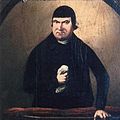History
The medieval Cinque Port of Rye, on a sandstone hill in the middle of flat marshland, [1] has (in common with the rest of Sussex) supported a great variety of Christian denominations over the centuries. [2] The earliest post-Reformation community were the Quakers, who founded a chapel on the south side of Mermaid Street in 1700 [3] or 1704. [4] They used this meeting house for the next half-century; but in 1753 it was reported as being "in a very dilapidated condition and past hope of repair". They sold the site to a congregation of Strict Baptists who had just formed in the town. They knocked down the decrepit building and erected a new chapel on the site; it was ready in 1754. [2] [3] [5] An adjacent house was taken over and used as a schoolroom for Baptist children. [4] The religious census of Sussex in 1851 recorded that the chapel had 280 sittings, 150 of which were free; and attendances at morning, afternoon and evening services were given as 80, 60 and 140 respectively. Fifty Sunday school children attended in the morning and afternoon as well. [6]
By 1900, the chapel had been joined by an array of other places of worship. The Church of the Holy Spirit, an Anglican church at Rye Harbour, was established in 1849; a Roman Catholic church was built in 1900; a second Strict Baptist chapel was founded in 1835; Methodists built their chapel in 1814 and extended it in 1852; and in 1882 a Congregational church was founded. [7] Meanwhile, some members of Rye Particular Baptist Chapel seceded from it in 1813 and founded a new independent Baptist church; they met in a house at first, but built their own chapel in 1817. [3] [8] The parish church, St Mary's, had existed since Norman times. [9]
In 1909, a new church was built in nearby Cinque Ports Street. It replaced yet another Baptist chapel of 1844; but the congregation of Rye Particular Baptist Chapel moved to it as well. The 1754 building was closed in 1910 and sold. [3] [5] It became a men's club [4] before being converted into a house, which took the name Quaker's House. [3]
Rye Particular Baptist Chapel, under its new name of Quaker's House, was designated a Grade II Listed building on 12 October 1951. [10]
This page is based on this
Wikipedia article Text is available under the
CC BY-SA 4.0 license; additional terms may apply.
Images, videos and audio are available under their respective licenses.




